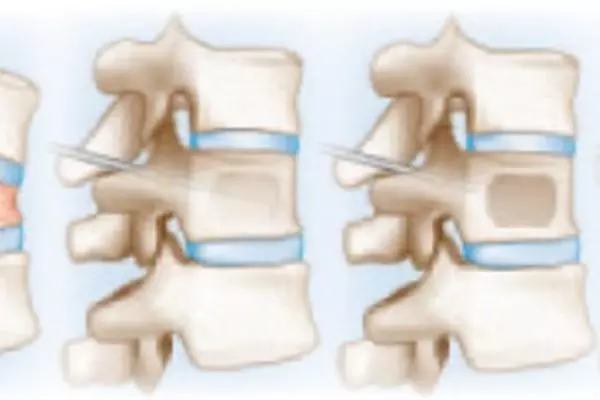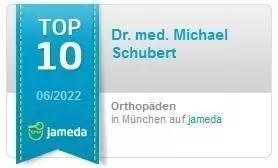Kyphoplasty
Therapy description - objective:
The aim of balloon kyphoplasty is to straighten and stabilize a collapsed vertebral body in such a way that no micro-movements can irritate the periosteum (the periosteum), thereby eliminating the main cause of the pain. For this purpose, the patient is positioned in such a way that a corresponding curvature of the spine already contributes to straightening and relieving the strain on the vertebral body.
Now, under x-ray control, two working cannulas are advanced through the skin from behind into the vertebral body on the left and right, and a balloon catheter is inserted in each case. These are now inflated with an X-ray contrast agent under X-ray control.
As a result, a symmetrical height reconstruction of the vertebral body can be achieved in most cases if the sintered fracture has not yet grown into a malposition. The balloon catheter removed after the fluid has been drained leaves a defined cavity in the vertebral body. This is filled with bone cement through the still lying working cannula under fluoroscopic control. The cement hardens within a few minutes, thus permanently stabilizing the vertebral body and preventing new fractures in the same vertebra.
Kyphoplasty
Vertebral fracture in osteoporosis
Vertebral collapse in osteoporosis is one of the most common complications. They can be very painful, often lead to severe back pain and can only be treated inadequately using conventional (conservative) methods. With this minimally invasive procedure, the fractured vertebral body can be straightened and stabilized immediately with viscous bone cement. In this way, the patient quickly regains freedom from pain and mobility.
What does the procedure include?
In balloon kyphoplasty, the collapsed vertebral body is straightened and stabilized again. For this purpose, the patient is positioned on his stomach in such a way that a corresponding curvature of the spine already contributes to straightening and relieving the strain on the vertebral body. Working cannulas are then inserted into the vertebral body from the left and right rear under X-ray control and a balloon catheter is inserted in each case. These are now inflated with an X-ray contrast medium. In most cases, this allows the vertebral body to be straightened evenly. The procedure is usually performed under general anesthesia but can also be performed under local anesthesia and takes about 1 hour.
What follow-up treatment and rehabilitation is required?
As a rule, the pain disappears immediately after the procedure, and patients can immediately begin to exercise. The patient can be discharged home one to two days after the operation. Only in rare cases do patients resort to a mild painkiller. On the day after the procedure, a medical check-up and an X-ray check will take place. In addition, a physiotherapist explains to the patient the correct postoperative behavior and the forthcoming rehabilitation measures, which can usually begin a week after the operation. A corset supply is usually not necessary.

The procedure takes place under local or general anesthesia.
The patient can bear weight immediately after the procedure and the desired pain reduction occurs quickly.
Minimally invasive, percutaneous and endoscopic/thoracoscopic surgical treatment of the spine
In the event of an accidental vertebral fracture with pre-existing reduced bone quality (e.g. osteoporosis), kyphoplasty of the fractured vertebral body alone is occasionally insufficient due to the resulting instability and resulting misalignment in the injured section of the spine. In addition, the position must be corrected and stabilized with implants. However, this usually requires a large skin incision and the removal of the back muscles. This leads to pronounced damage to the muscles with a relevant pain burden. With the most modern techniques and implants, a long-term stabilization and simultaneous correction of a misalignment can be introduced via small skin punctures (percutaneously), whereby the entire back muscles are completely preserved. Due to the small wound areas, the risk of infection or impaired healing is significantly lower than with the usual procedures. In the hands of very experienced surgeons, the duration of the operation is significantly reduced compared to the usual open procedures, while at the same time improving the safety of the operation. The in-patient stay is considerably shortened, and the minimal post-operative pain allows immediate mobilization without the usual rest in bed. This modern, minimally invasive procedure can also be used for long-distance stabilization combined with complex reconstruction procedures such as vertebral body replacement operations. A necessary surgical treatment of the front section of the spine is not carried out via large incisions in the area of the chest, but via endoscopic/thoracoscopic techniques, with which all supplies can be carried out via the smallest accesses with video control. In this way, extensive inflammatory changes, tumors in individual sections of the spine, as well as malpositions can be treated and corrected in a minimally invasive manner.
The advantages at a glance:
- Modern balloon kyphoplasty ensures immediate freedom from pain and
unrestricted functionality of the damaged lumbar spine - A feared connection degeneration can usually be avoided
- Independent movement and walking possible immediately after the operation
- Speedy recovery and pain relief
- No longer hospital stay is necessary:
In general, you can go home two to four days after the operation. - You can largely resume your usual activities six weeks after the operation
- Short rehabilitation phase and quick return to work (4 - 6 weeks)
- A high success rate of approx. 95%


